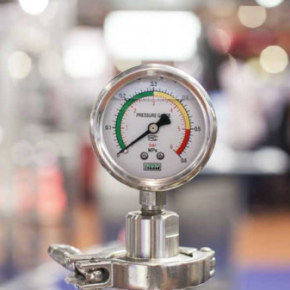
GUEST ARTICLE: Eight common reasons for pressure gauge failure
The following guest article focuses on eight of the most common causes for premature gauge failure to look out for and how to avoid equipment downtime.
Pressure gauges are a vital component in any system, helping users determine whether the process is running safely. Once they have been calibrated, pressure gauges are one of the most reliable tools for process monitoring and control. However, no matter how robust your pressure gauges may seem, eventually they will need replacing.
If you notice that you are fitting new gauges more often than you expect, it’s important to look for the cause of premature failure. A broken gauge can be the sign of something else in your system malfunctioning or working inefficiently, and not knowing whether a pressure gauge is reading accurately can lead to poor decision making.
============================
1. Misuse or mishandling
Unsurprisingly, human error is one of the most common causes for mechanical components to fail or display incorrect readings. This could be a simple as installing the gauge incorrectly, installing the wrong type of gauge or accidentally damaging the instrument during inspection, calibration or use.
Make sure that the pressure gauge is installed somewhere with a low risk of damage. This includes making sure that it can be easily read – you don’t want someone forcing it into a different position just so they can see the meter better.
2. Corrosion
It might sound obvious, but if you’re using highly-corrosive media, check that your gauge is made from the right materials. If it isn’t designed to resist the substance that’s flowing through your system, the media will be damaging the internal mechanism of the gauge.
You may be able to replace your gauge with a more robust model or install a diaphragm seal that can tolerate the corrosive material in your process.
3. Clogged pipes
If you are working with media that is prone to build-up or crystallisation, it may be that your pressure gauge essentially becomes clogged. This is especially dangerous as a clogged gauge will typically ‘freeze’, indicating a safe reading when actually the system is under increasing pressure due to build-up.
Protect your pressure gauge by installing a diaphragm seal that uses flushing ports to keep the seal free from build-up.
4. Overpressure
Hopefully you have installed a gauge that is appropriate for your standard system pressure, however, check that it’s capable of tolerating abnormalities in the pressure flow too. For example, if the system relies on pumps that switched on and off or valves that open and close, the associated surges can cause the pressure gauge to spike, damaging it.
Ensure that the maximum pressure tolerance for the gauge far exceeds the expected pressure in your system, so that occasional spikes or surges in delivery don’t cause problems.
5. Pulsating pressure
Pulsating media flowing through your pipes is damaging in the same way as overpressure. By causing your pressure gauge to rapidly spike with an overpressure reading, it will cause the internal mechanism to wear down faster than usual.
A ‘pressure snubber’ or restrictor will regulate the pressure of your media by restricting the size of the intake channel into the gauge. This will ultimately result in a smoother, more consistent reading as well an prolonging the life of the gauge.
6. Excessive vibration
In a pressurised environment, it’s not unusual for various parts of equipment to vibrate. However, continuous and excessive vibration can negatively affect your pressure gauges, incrementally damaging the pointer mechanism so that it moves off zero. You may also find that, depending on your gauge, it’s difficult to accurately read the pointer due to the excessive shaking from equipment vibrations.
To avoid this, install a vibration-resistant gauge that is filled with liquid or oil to dampen the effects of the vibration. Alternatively, you could affix the gauge to a remote, stationary mount and use a capillary line to connect it to your piping.
7. Temperature
Make sure your gauge is rated for the temperatures it’s working at, otherwise you may find that extreme temperatures are causing faulty readings and damage. Excessive heat can cause metal joints to become loose and crack, while very low temperatures can affect the motion of a pressure gauge.
8. Steam interference
It’s common for industrial processes to use high-pressure steam at some point in the system. However, if these vapours are able to seep into the mechanism of your pressure gauge, they can cause the internal mechanism to weaken and eventually fail.
The best prevention for this is to install a mini-siphon that that cools hot gas and vapour in an internal chamber to minimise the effect on the gauge.
===========================
If you are having trouble with gauges that are repeatedly failing, these are the most common causes to look out for. Identifying the cause of the problem will not only alleviate your frustration, but make sure that your equipment is reading accurately for safer, more efficient processes.
Latest news

9th April 2025
Insight Data: Smart spending - how targeted marketing offsets rising costs
As ‘Awful April’ lands, fenestration businesses must use data-driven marketing to maximise impact, cut waste and stay ahead, says Alex Tremlett, Insight Data’s commercial director…
Posted in Articles, Building Industry News, Building Products & Structures, Building Services, Doors, Glass, Information Technology, news, Posts, Research & Materials Testing, Windows
9th April 2025
Saniflo: Retrofit 2025 at the Building Centre
Saniflo is delighted to announce a six-month collaboration with the Building Centre as a Principal Partner for ‘Retrofit 2025 – What’s Stopping Us’.
Posted in Articles, Bathrooms & Toilets, Bathrooms, Bedrooms & Washrooms, Building Industry Events, Building Industry News, Building Products & Structures, Building Services, Case Studies, Drainage, Exhibitions and Conferences, Facility Management & Building Services, Innovations & New Products, Interiors, Pipes & Fittings, Plumbing, Restoration & Refurbishment, Retrofit & Renovation
9th April 2025
FIT Show Launches Comprehensive CPD Learning Programme - Registration Now Open!
FIT Show, the UK’s leading trade event for the window, door, flat glass, hardware, components, and roofing industries, has unveiled its extensive learning programme for the 2025 event.
Posted in Architectural Ironmongery, Articles, Building Industry Events, Building Industry News, Building Products & Structures, Building Services, Building Systems, Continuing Professional Development (CPD's), Doors, Exhibitions and Conferences, Glass, Glazing, Innovations & New Products, Posts, Restoration & Refurbishment, Roofs, Seminars, Timber Buildings and Timber Products, Training, Windows
8th April 2025
First look at industry speakers for GEO Business 2025
GEO Business, the UK’s premier geospatial event, is set to return to ExCeL London on 4 – 5 June 2025, bringing together the brightest minds in the industry.
Posted in Articles, Building Industry Events, Building Industry News, Building Products & Structures, Building Services, Exhibitions and Conferences, Information Technology, Innovations & New Products, Restoration & Refurbishment, Retrofit & Renovation, Seminars
 Sign up:
Sign up: 